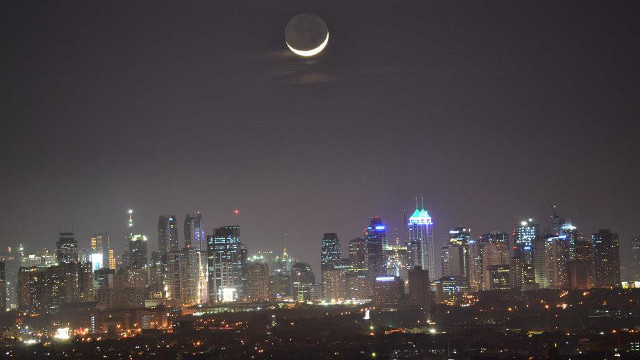SUMMARY
This is AI generated summarization, which may have errors. For context, always refer to the full article.

MANILA, Philippines – Okay, so December 21, 2012 came, went and we’re all still standing — a rogue planet did not destroy Earth.
For 2013, there are plenty of astronomical phenomena to look forward to.
Bamm Gabriana, founding member of the U.P. Astronomical Society and instructor at the Rizal Technological University Department of Astronomy lists down these top astronomical events for 2013 (Time to take out your planners, jot these dates down and schedule that sky-watching date with your friends or family!):
# 9 – January 21, 2013: Jupiter is half a degree from the Moon
This will make an interesting celestial photo-op with the Moon and Jupiter very close together in the sky. You can play 3rd wheel and position yourself in the foreground!
# 8 – May 29: Planetary grouping of Mercury, Venus and Jupiter
Three planets, including two of the brightest (Venus and Jupiter), will pose together in the sky. Don’t miss this visually breathtaking event.
# 7 – April 28: Saturn at opposition
Saturn, dubbed the “lord of the rings” by astronomers, will be seen from sundown to sunrise. Many astronomy enthusiasts begin their journey by seeing Saturn on a telescope. Want your child to be an astronomer? Let her see Saturn!
# 6 – May 6: Eta-Aquarid Meteor Shower
Though Eta-Aquarids is the least popular meteor shower in the country, Gabriana says it’s one of the best because it occurs in summer when the weather is usually good. The number of meteors that appear in the sky hourly is also fairly high.
He also predicts a particularly good shower just before sunrise on this day when the Philippines is almost a direct hit of the meteoroid stream from Halley’s Comet!
# 5 – August 7: Thinnest moon crescent
There is something surreal and beautiful about a thin crescent moon, is there not? Those who agree will turn their eyes skyward on this night when the moon crescent is thinnest because of the moon being only 7 degrees from the sun.
Seven degrees away on the seventh day of the seventh month? Could there be a prophecy about this somewhere? On that day, the sun will set at 5:55 PM and the moon at 6:04 PM so you only have 9 minutes to find the moon!
# 4 – April 26: Partial lunar eclipse
This is the only eclipse visible in Manila in 2013 and, sadly, it’s only a partial one.
Here are the circumstances computed for the PAGASA Observatory in Quezon City:
- Moon enters penumbra – 02:01:44 AM
- Moon enters umbra – 03:51:42 AM
- Maximum eclipse – 04:07:30 AM
- Moon leaves umbra – 04:23:27 AM
- Moon leaves penumbra – 06:13:17 AM
# 3 – May 10: Annular solar eclipse
This eclipse will be visible only in Visayas and Mindanao. The “borderline” of the eclipse crosses the Philippines such that Manila observers will not see the eclipse at all. Thus, the farther south you go, the better.
Here are the circumstances for Davao City:
- First contact – 06:06:31 AM
- Maximum eclipse – 06:47:38 AM
- Last contact – 07:32:40 AM
An important reminder for viewing solar eclipses: use protective filters as rays of the sun can burn your retina. According to Gabriana, sunglasses and even X-ray films are not enough. He recommends using #14 welder’s glass or neutral-density 5.0 filters.
# 2 – March 28: Occultation of Spica
Most of us are familiar with eclipses, but did you know that the moon also eclipses other stars apart from the sun? This is called Lunar Occultation.
Spica is a star along the moon’s orbital plane, but it is special because it is one of the brightest stars in the sky — what astronomers call a “first-magnitude” star.
At 8:50 PM, Spica will disappear behind the moon, and then reappear at 9:53 PM. Very few people have seen a lunar occultation of a star so don’t miss this opportunity!
# 1 – Early November to end of November: Comet ISON
The last time a really bright comet was visible in the sky was when Hale-Bopp showed up in 1997. After 15 years of waiting, finally, another naked-eye comet is coming: C/2012 S1 (ISON).
It will first appear in the early morning sky at the start of November and will gradually grow brighter. It will reach its brightest near the end of November. If calculations by astronomers are correct, it might even be bright enough to be visible at daytime! But after that, it will fade until it disappears from view.
To increase your chances of witnessing these astronomical events, get yourselves to these space observatories that not only have viewing decks and powerful telescopes but are second homes to astronomers who can help explain the significance of the astronomical phenomena to you and your companions:
Space observatories in Metro Manila and within its vicinity include:
- The PAGASA Observatory in the University of the Philippines Diliman campus in Quezon City
- The Manila Observatory in the Ateneo de Manila University campus (also in Quezon City)
- The Seven Suites Hotel Observatory along Sumulong Highway in Antipolo City
Ramon Acevedo, in-house astronomer at the Seven Suites Hotel (and also a member of the U.P. Astronomical Society) says that there is a meteor shower almost every month, at which times the hotel makes announcements on its website. Its telescope is the 4th largest in the country, equipped with a 12-inch mirror.
Just make sure not to come on a Tuesday, the only day of the week when the observatory is closed.
With the many astronomical events to look forward to, we can definitely expect a stellar year ahead. Happy new year, everyone! – Rappler.com
Add a comment
How does this make you feel?
There are no comments yet. Add your comment to start the conversation.